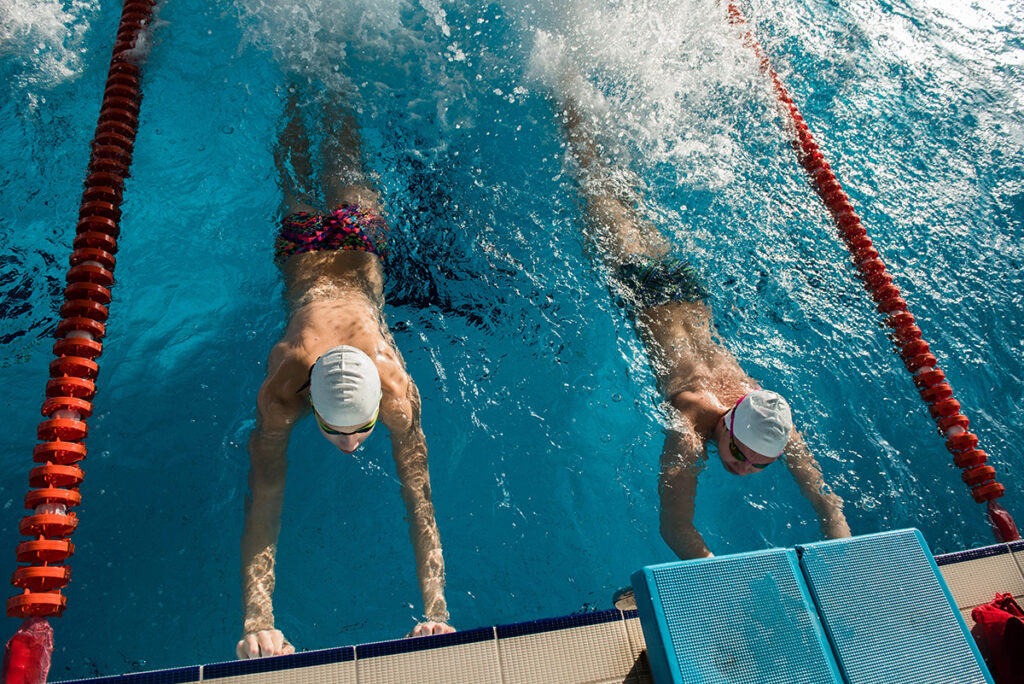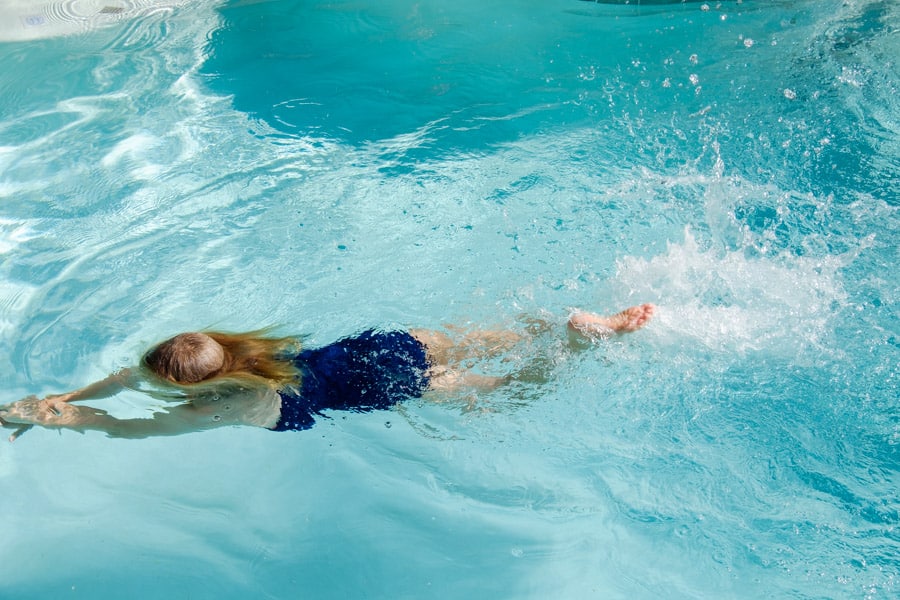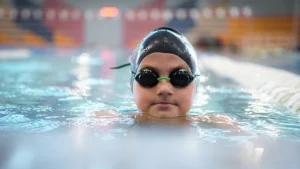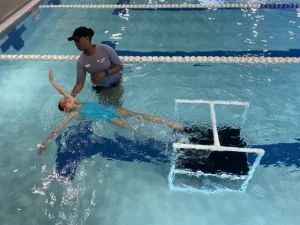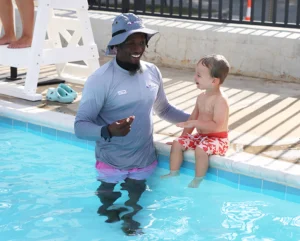Perfect Your Flutter Kick When You Train Like a Pro
Flutter kicks are the most fundamental skill in swimming. When performed correctly, this kick is 10-30% responsible for propelling you in both backstroke and freestyle.
In this comprehensive guide, we’re breaking down the proper technique, common mistakes to avoid, which muscles you’re working on, and helpful drills to perfect your flutter kicks!
Anatomy of the Perfect Flutter Kick
A proper flutter kick involves coordinated movement of your legs, driven from your hips and ending with pointed toes.
Here’s a breakdown of what you want to do:
Hip-Driven Motion: The kick should originate from your hips, not your knees. This means that your entire leg is involved in the kick movement.
Straight Legs: Keep your legs relatively straight throughout the kick. A slight bend at the knee is natural, but excessive bending should be avoided.
Pointed Toes: Your toes should be pointed— think of a ballet dancer’s foot position. This helps create a streamlined shape and allows you to push water effectively with both the top and the sole of your foot.
Small, Quick Kicks: The most efficient flutter kicks are small and rapid. Large, slow kicks can create unnecessary drag and reduce your overall speed.
Underwater Movement: Your feet should remain underwater throughout the entire kicking motion. When you break the surface, you create unnecessary splashing and reduce your propulsion.
Alternating Pattern: Flutter kicks follow an alternating pattern, with one leg moving up as the other is moving down.
Common Mistakes and How to Avoid Them
Even experienced swimmers can fall into bad habits with their flutter kicks. Enlist your instructor to help you practice proper flutter kicks.
Here are some common mistakes to watch out for:
Bicycle Kicking
Mistake: This might be the most common error, where swimmers bend their knees excessively, creating a cycling motion instead of a flutter. This drastically reduces propulsion and increases drag.
Correction: Focus on keeping your legs straight and kicking from your hips. Imagine your legs as a whip, with the power originating from your hips.
Breaking the Surface
Mistake: When you let your feet come out of the water during the upward phase of the kick, it creates unnecessary splashing and reduces efficiency.
Correction: Keep your kicks small and controlled so your feet remain submerged throughout the entire motion.
Kicking Too Wide
Mistake: Sometimes, swimmers let their legs spread too far apart, disrupting body alignment and creating drag.
Correction: Keep your kicks within the width of your body. Imagine kicking inside a narrow cylinder.
Neglecting the Upkick
Mistake: Many swimmers focus entirely on the downward phase of the kick, neglecting the potential propulsion from the upward movement.
Correction: Pay attention to both phases of the kick. The upward movement should be active, not just a passive return to the starting position.
Rigid Ankles
Mistake: When you stiffen your ankles, you reduce the surface area available to push against the water. This limits the amount of propulsion you’re going to get.
Correction: Work on ankle flexibility—practice pointing and flexing your feet to increase your range of motion.
Muscles Worked in Flutter Kicks
Even though swimming is a full-body workout, understanding which muscles are engaged during flutter kicks can help you focus on strengthening these areas for improved performance.
The primary muscles worked on include:
Quadriceps: The large muscles at the front of your thighs are crucial for the downward phase of the kick.
Hamstrings: Located at the back of the thighs, these muscles engage during the upward phase of the kick.
Glutes: Your buttock muscles provide power and stability throughout the kicking motion.
Hip Flexors: These muscles at the front of your hips are essential for driving the kick from your core.
Calves: The muscles in your lower legs help to point your toes and maintain tension throughout the kick.
Core Muscles: Your abdominals and lower back muscles work to maintain body position and transfer power from your upper body to your legs.
Ankle and Foot Muscles: These smaller muscles are crucial for maintaining pointed toes and creating an effective surface to push against the water.
Drills to Perfect Your Kicks
Anytime you want to improve your swimming skills, from stroke technique to endurance, you’ll need to incorporate drills.
Here are some examples you can use during your training sessions:
Noodle Drill
Use a pool noodle to support your upper body while practicing flutter kicks. Hold the noodle in front of you, allowing it to provide buoyancy without using it as a floatation device. This drill helps you focus on your kicking technique while maintaining proper body alignment.
Kickboard
Hold a kickboard with extended arms, face in the water, and practice flutter kicks. This will allow you to focus entirely on your leg movement while maintaining proper alignment.
Vertical Kicking
In deep water, practice flutter kicks while maintaining a vertical position. This challenges your kick strength and endurance.
Single Leg Kicks
Alternate between kicking with just your right leg and just your left leg. This helps identify and adjust any imbalances in your kick.
Streamline Kicking
Push off the wall in a streamlined position (arms extended overhead, hands clasped) and kick without using your arms. This promotes body alignment and kick efficiency.
Side Kicking
Practice flutter kicks on your side, simulating your body position during side breathing in freestyle. This helps develop a balanced, symmetrical kick and improves your feel for the water.
Incorporating Flutter Kicks into Your Training
Photo credit: Swimmer Central
If you really want to master flutter kicks, consistent training is the only way to get there.
Here are some exercises to challenge you:
Warm-Up
Begin each swim session with a few laps of kick-only swimming to warm up your legs and reinforce proper technique. This can include using a pool noodle or kickboard.
Kick Sets
Include dedicated kick sets in your workouts, using a variety of distances, intensities, and body positions (front, back, and side).
Drill Integration
Incorporate flutter kicks into your regular swim sets. For example, do one lap of normal freestyle followed by one lap of kickboard kicking.
Varied Intensity
Mix up your kick practice with different intensities. For example, swim one length of the pool fast to build strength and endurance, then finish up the lap slowly with controlled kicks to improve technique.
Feel the Water
During your practice, focus on feeling the water. Be mindful of how your feet interact with the water during both up and down phases.
Video Analysis
Periodically record your flutter kicks (both underwater and from above) to identify areas of improvement. Pay attention to how straight your legs are, knee position, and overall body alignment.
Quality over Quantity: Perfect Your Kick Through Practice
Remember, flutter kick practice isn’t just about how many laps you swam or how much time you spent in the water— it’s about the quality of the practice.
Focus on maintaining the proper form and getting the feeling of the water, even if it means slowing down to get it right. As your technique improves, you’ll find that your kicks become more efficient and powerful!
Want to join a program dedicated to training and technique? The WeAquatics Young Masters Program is for kids who love to swim, want to improve their skill set, and maybe even compete. Our Adult Masters Program is for anyone 18 and over who wants a dedicated opportunity to train in a group setting, whether to stay healthy or compete.

